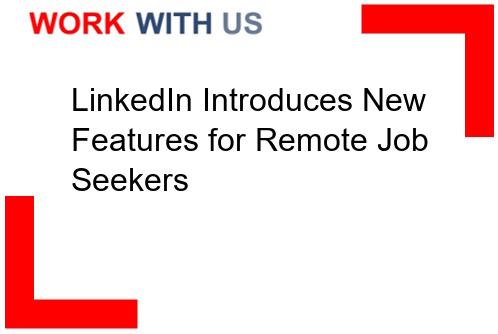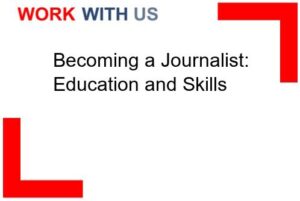LinkedIn, the popular professional networking platform, has recently rolled out a series of new features aimed at helping remote job seekers navigate the increasingly competitive job market. With the rise of remote work opportunities in the wake of the COVID-19 pandemic, LinkedIn has recognized the need to provide its users with tools and resources to stand out in a virtual job search.
One of the key features introduced by LinkedIn is the ability for users to specify their remote work preferences directly on their profiles. This allows job seekers to clearly communicate to potential employers their desire for remote work opportunities, making it easier for recruiters to identify candidates who are a good fit for remote positions. By indicating their remote work preferences, users can increase their chances of being contacted for relevant job opportunities and streamline the job search process.
In addition to remote work preferences, LinkedIn has also introduced a new “Remote Jobs” tab on its platform, making it easier for users to discover and apply for remote job openings. This dedicated section showcases a curated list of remote job listings from companies across various industries, allowing job seekers to browse through opportunities that align with their skills and interests. By centralizing remote job listings in one convenient location, LinkedIn is helping users save time and effort in their job search.
Furthermore, LinkedIn has enhanced its job search filters to include specific criteria related to remote work, such as location flexibility and remote work options. This allows users to refine their job search results to only show remote job opportunities that meet their preferences, making it easier to find relevant positions in a competitive job market. By leveraging these advanced search filters, remote job seekers can focus their efforts on opportunities that align with their desired work arrangements.
Another notable feature introduced by LinkedIn is the ability for users to showcase their remote work skills and experience on their profiles. This includes highlighting relevant remote work experience, certifications, and skills that demonstrate their ability to excel in a remote work environment. By emphasizing their remote work capabilities, users can differentiate themselves from other job seekers and attract the attention of recruiters looking for candidates with remote work experience.
Overall, LinkedIn’s new features for remote job seekers reflect the platform’s commitment to supporting its users in adapting to the changing landscape of work. By providing tools and resources specifically tailored to remote job seekers, LinkedIn is empowering professionals to navigate the virtual job market with confidence and success. Whether users are actively seeking remote job opportunities or simply exploring their options, LinkedIn‘s new features offer valuable support in finding and securing remote work opportunities.
How linkedin’s new remote job seeker features are revolutionizing the job search process
LinkedIn, the world’s largest professional networking platform, has recently introduced new features specifically designed to cater to remote job seekers. These innovative tools are revolutionizing the job search process by providing users with more opportunities to find and secure remote work positions.
One of the key features that LinkedIn has rolled out is the ability for users to set their job preferences to indicate that they are specifically seeking remote work opportunities. This allows job seekers to easily filter out job listings that require on-site work and focus solely on remote positions. By doing so, users can save time and energy that would have otherwise been spent sifting through irrelevant job postings.
In addition to setting preferences for remote work, LinkedIn now also allows users to search for jobs based on specific remote work criteria. This includes options such as full-time remote work, part-time remote work, or even freelance opportunities. By providing these tailored search options, LinkedIn is making it easier for remote job seekers to find positions that align with their desired work arrangements.
Furthermore, LinkedIn has introduced a new feature that enables users to signal to recruiters that they are open to remote work opportunities. This feature, known as the #OpenToWork setting, allows users to add a banner to their profile photo indicating their willingness to consider remote work positions. By doing so, job seekers can increase their visibility to recruiters who are specifically looking to fill remote roles.
Another way in which LinkedIn is revolutionizing the job search process for remote job seekers is through its enhanced job recommendations algorithm. By analyzing a user’s profile, job preferences, and activity on the platform, LinkedIn is able to provide more personalized job recommendations that are tailored to the user’s remote work preferences. This not only saves time for job seekers but also increases the likelihood of finding relevant job opportunities.
Moreover, LinkedIn has expanded its remote job listings to include a wider range of industries and job functions. This means that remote job seekers are no longer limited to certain fields or roles when searching for remote work opportunities. Whether someone is looking for a remote marketing position, a remote software development role, or even a remote customer service job, LinkedIn now offers a diverse range of remote job listings to cater to different career paths.
Additionally, LinkedIn has introduced new tools to help remote job seekers showcase their skills and experience more effectively. For example, users can now add a “Skills Assessment” to their profile to demonstrate their proficiency in specific areas. This can help remote job seekers stand out to recruiters and hiring managers who are looking for candidates with verified skills and expertise.
Furthermore, LinkedIn has enhanced its messaging features to facilitate communication between remote job seekers and recruiters. Users can now easily reach out to recruiters to inquire about remote job opportunities or ask questions about specific job listings. This streamlined communication process can help remote job seekers build relationships with recruiters and potentially secure remote work positions more efficiently.
Overall, LinkedIn’s new remote job seeker features are transforming the job search process for remote job seekers. By providing tailored search options, enhanced job recommendations, expanded job listings, and improved communication tools, LinkedIn is making it easier for remote job seekers to find and secure remote work opportunities. As the demand for remote work continues to grow, these new features are helping job seekers navigate the evolving job market and find opportunities that align with their desired work arrangements.
A comprehensive guide to using linkedin’s latest features for remote job seekers
LinkedIn is a powerful tool for job seekers, especially for those looking for remote opportunities. With the rise of remote work, LinkedIn has introduced several new features to help job seekers find and apply for remote positions more easily. By utilizing these latest features, remote job seekers can increase their chances of finding their dream job from the comfort of their own home.
One of the most useful features for remote job seekers on LinkedIn is the ability to set job preferences. Users can specify their desired job title, location, industry, and job type (such as remote or work from home). By setting these preferences, LinkedIn will show users relevant job listings that match their criteria, making it easier to find remote opportunities that align with their skills and experience.
Another helpful feature for remote job seekers is the option to signal to recruiters that they are open to remote work. This feature allows users to indicate on their profile that they are interested in remote opportunities, making it easier for recruiters to find them when searching for candidates for remote positions. By enabling this feature, remote job seekers can increase their visibility to recruiters looking to fill remote roles.
LinkedIn also offers a feature called “Easy Apply” which allows users to apply for jobs with just a few clicks. This feature is especially useful for remote job seekers who may be applying to multiple positions. By using Easy Apply, users can quickly submit their application to remote job listings without having to fill out lengthy application forms or upload multiple documents. This can save remote job seekers time and effort in the application process.
In addition to these features, LinkedIn has also introduced a new feature called “Career Interests” which allows users to specify their job preferences and career goals. Users can indicate their desired job title, location, industry, and job type, as well as their availability and preferred start date. By using Career Interests, remote job seekers can signal to recruiters that they are actively looking for remote opportunities and are ready to make a career move.
Overall, LinkedIn’s latest features make it easier than ever for remote job seekers to find and apply for remote positions. By setting job preferences, signaling interest in remote work, using Easy Apply, and utilizing Career Interests, remote job seekers can increase their chances of landing their ideal remote job.
Networking on LinkedIn for Remote Job Seekers
Networking is a crucial aspect of finding a remote job on LinkedIn. Remote job seekers can connect with professionals in their industry, join relevant groups, and engage with content to expand their network. By building relationships with other professionals, remote job seekers can gain insights into remote job opportunities and connect with potential employers.
Building a Strong LinkedIn Profile for Remote Job Seekers
Having a strong LinkedIn profile is essential for remote job seekers. Remote job seekers should optimize their profile with relevant keywords, a professional photo, a compelling headline, and a detailed summary of their skills and experience. By showcasing their remote work experience and skills on their profile, remote job seekers can attract the attention of recruiters looking to fill remote positions.
Showcasing Remote Work Skills on LinkedIn
Remote job seekers should highlight their remote work skills on their LinkedIn profile. Skills such as time management, communication, self-motivation, and adaptability are highly valued in remote work environments. By showcasing these skills on their profile, remote job seekers can demonstrate to potential employers that they are well-suited for remote positions.
Utilizing LinkedIn Groups for Remote Job Seekers
LinkedIn Groups are a valuable resource for remote job seekers. Remote job seekers can join groups related to remote work, their industry, or their job function to connect with like-minded professionals and stay updated on remote job opportunities. By actively participating in groups, remote job seekers can expand their network and access valuable resources for finding remote work.
Engaging with Content on LinkedIn for Remote Job Seekers
Engaging with content on LinkedIn is another effective way for remote job seekers to increase their visibility and attract the attention of recruiters. Remote job seekers can like, comment, and share relevant posts to showcase their expertise and engage with other professionals in their industry. By staying active on LinkedIn and sharing valuable insights, remote job seekers can position themselves as thought leaders in their field and increase their chances of finding remote job opportunities.
The impact of linkedin’s new features on remote job seekers and employers
LinkedIn, the world’s largest professional networking platform, has recently introduced a range of new features that are set to have a significant impact on remote job seekers and employers alike. These new features are designed to enhance the user experience, streamline the job search process, and facilitate connections between job seekers and employers in the remote work landscape.
One of the key new features on LinkedIn is the ability for users to specify their preferred work location as remote. This feature allows remote job seekers to easily identify and apply for job opportunities that offer the flexibility of working from anywhere. By selecting the remote work option, job seekers can filter out job listings that require on-site presence, saving time and effort in their job search.
In addition to the remote work location feature, LinkedIn has also introduced a new “Skills Assessments” tool. This tool allows job seekers to showcase their skills and expertise through a series of online assessments. By completing these assessments, job seekers can demonstrate their proficiency in specific areas and increase their chances of being noticed by potential employers. For remote job seekers, this feature can be particularly valuable as it helps them stand out in a competitive job market where remote work skills are in high demand.
Furthermore, LinkedIn has revamped its messaging platform to make it easier for job seekers to connect with recruiters and hiring managers. The new messaging features include the ability to send voice messages, share attachments, and schedule meetings directly within the platform. These enhancements enable remote job seekers to communicate more effectively with potential employers, build relationships, and ultimately secure job opportunities in a remote work setting.
Another notable feature on LinkedIn is the “Open to Work” badge, which allows job seekers to signal to recruiters that they are actively seeking new opportunities. This badge appears on a user’s profile picture and can be customized to indicate the type of job they are looking for, such as remote work. By using the “Open to Work” badge, remote job seekers can increase their visibility to recruiters and receive more relevant job opportunities tailored to their preferences.
For employers, LinkedIn’s new features offer valuable tools to attract and engage with remote talent. The platform’s enhanced job posting options allow employers to specify remote work arrangements, highlight flexible work policies, and target remote job seekers more effectively. By leveraging these features, employers can reach a wider pool of qualified candidates who are seeking remote work opportunities, ultimately leading to better hiring outcomes for remote positions.
Moreover, LinkedIn’s new features enable employers to showcase their company culture and values to remote job seekers. The platform’s company pages now include sections for showcasing remote work policies, employee testimonials, and virtual events. By providing insights into their remote work environment, employers can attract top remote talent who align with their organizational values and work culture.
In conclusion, LinkedIn’s new features have the potential to revolutionize the way remote job seekers and employers connect and collaborate in the digital age. By leveraging these features, remote job seekers can more easily identify and apply for remote job opportunities, showcase their skills and expertise, and communicate effectively with potential employers. Similarly, employers can use LinkedIn’s new tools to target and engage with remote talent, showcase their company culture, and streamline the hiring process for remote positions. Overall, LinkedIn‘s new features are poised to have a positive impact on the remote work landscape, facilitating meaningful connections and opportunities for both job seekers and employers.
Leveraging linkedin’s enhanced tools for remote job seekers to land your dream job
LinkedIn has become an essential tool for job seekers, especially in the current remote work environment. With the rise of remote job opportunities, leveraging LinkedIn’s enhanced tools can significantly increase one’s chances of landing their dream job. By utilizing features such as LinkedIn’s job search filters, networking capabilities, and online courses, remote job seekers can stand out to potential employers and showcase their skills and expertise effectively.
Utilizing LinkedIn’s job search filters
One of the key features that remote job seekers can leverage on LinkedIn is the job search filters. These filters allow users to narrow down their job search based on specific criteria such as job title, location, industry, and company size. By using these filters effectively, job seekers can save time and focus on opportunities that align with their skills and career goals. Additionally, LinkedIn’s job search filters can help remote job seekers discover hidden job opportunities that may not be easily accessible through traditional job search methods.
Networking on LinkedIn
Networking is crucial for remote job seekers, as it can help them connect with industry professionals, recruiters, and potential employers. LinkedIn’s networking capabilities make it easy for job seekers to expand their professional network and build relationships with key players in their industry. By engaging with relevant content, participating in LinkedIn groups, and reaching out to connections for informational interviews, remote job seekers can increase their visibility and attract job opportunities. Networking on LinkedIn can also provide valuable insights into the remote job market and help job seekers stay updated on industry trends and developments.
Showcasing skills and expertise
LinkedIn offers remote job seekers the opportunity to showcase their skills and expertise through their profile. By optimizing their LinkedIn profile with relevant keywords, a professional summary, and a complete work experience section, job seekers can make a strong impression on potential employers. Additionally, remote job seekers can use LinkedIn’s portfolio feature to showcase their work samples, projects, and certifications. By highlighting their achievements and demonstrating their capabilities, job seekers can differentiate themselves from other candidates and increase their chances of landing their dream job.
Taking advantage of online courses
LinkedIn Learning, the platform’s online learning portal, offers a wide range of courses and tutorials on various topics such as remote work, digital skills, and industry-specific knowledge. Remote job seekers can take advantage of these online courses to upskill, reskill, and stay competitive in the job market. By completing relevant courses and adding them to their LinkedIn profile, job seekers can demonstrate their commitment to professional development and continuous learning. Employers value candidates who are proactive about improving their skills and staying updated on industry trends, making online courses a valuable resource for remote job seekers.
Building a personal brand
In the competitive job market, building a strong personal brand is essential for remote job seekers. LinkedIn provides a platform for job seekers to establish their personal brand by sharing thought leadership content, engaging with industry influencers, and showcasing their unique value proposition. By consistently posting relevant content, participating in conversations, and positioning themselves as experts in their field, remote job seekers can attract the attention of potential employers and create opportunities for themselves. Building a personal brand on LinkedIn can help job seekers stand out from the crowd and position themselves as top candidates for their dream job.
In conclusion, leveraging LinkedIn’s enhanced tools for remote job seekers can be a game-changer in the job search process. By utilizing job search filters, networking capabilities, showcasing skills and expertise, taking advantage of online courses, and building a personal brand, remote job seekers can increase their visibility, attract job opportunities, and land their dream job. With the right strategy and consistent effort, job seekers can use LinkedIn as a powerful tool to advance their career and achieve their professional goals.



